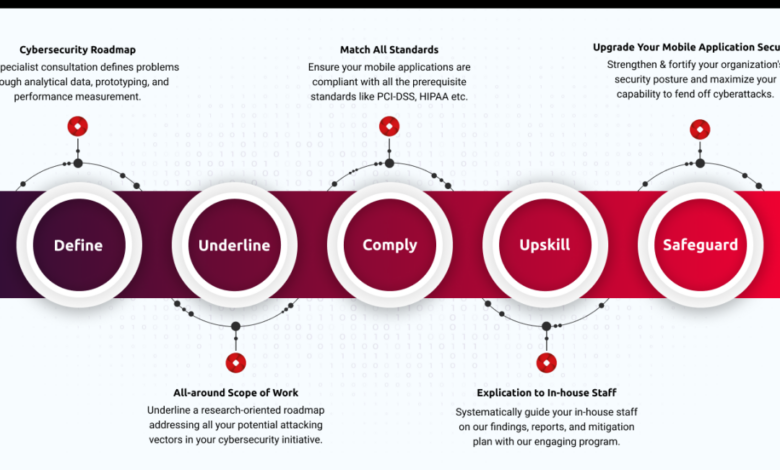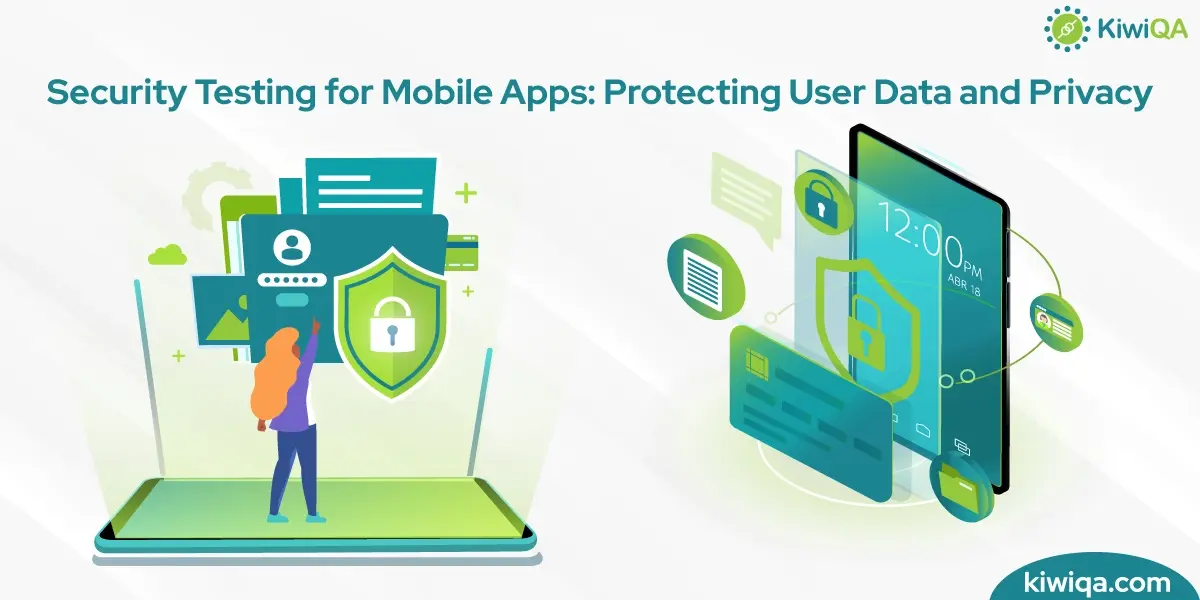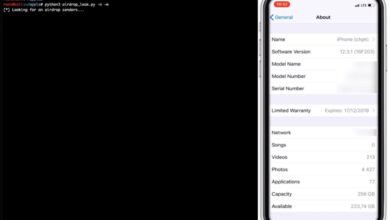
A Comprehensive Guide to Mobile Application Security Testing
A comprehensive guide to mobile application security testing is more than just a technical manual; it’s your survival guide in the wild west of mobile apps. Think about it – your phone holds your life: banking details, personal photos, private messages. This guide dives deep into the crucial world of securing those precious digital assets, exploring everything from static and dynamic analysis to penetration testing and platform-specific vulnerabilities.
We’ll unpack the OWASP Mobile Security Project, examine various testing methodologies, and even show you some cool tools to help you along the way. Get ready to level up your app security game!
We’ll cover the essential techniques for both Android and iOS, ensuring you’re equipped to tackle any security challenge. We’ll explore secure coding practices, delve into data security and privacy concerns, and equip you with the knowledge to navigate the complexities of compliance regulations. By the end, you’ll have a solid understanding of how to build and test secure mobile applications, protecting yourself and your users from the ever-evolving landscape of cyber threats.
Introduction to Mobile Application Security Testing
In today’s hyper-connected world, mobile applications are integral to almost every aspect of our lives, from banking and shopping to healthcare and social interaction. This widespread reliance makes mobile app security paramount. A single vulnerability can expose sensitive user data, leading to financial losses, reputational damage, and even legal repercussions for both users and developers. Thorough security testing is no longer a luxury; it’s a critical necessity.Mobile application security testing (MAS) is a multifaceted process designed to identify and mitigate security risks within mobile applications.
It involves a systematic evaluation of an app’s code, functionality, and infrastructure to uncover weaknesses that could be exploited by malicious actors. The goal is to ensure the confidentiality, integrity, and availability of the application and its data.
Types of Mobile Application Security Testing
Mobile app security testing employs various methodologies, each with its own strengths and limitations. Three prominent approaches are static analysis, dynamic analysis, and penetration testing.Static analysis examines the application’s source code or compiled binaries without actually executing the application. This method identifies potential vulnerabilities through code review, automated tools, and manual inspection. It’s effective for finding flaws early in the development lifecycle but might miss runtime issues.Dynamic analysis, on the other hand, involves testing the application while it’s running.
This allows for the detection of vulnerabilities that only appear during runtime, such as memory leaks or insecure data handling. Dynamic analysis techniques often utilize tools that monitor the application’s behavior and network traffic.Penetration testing simulates real-world attacks against the application to assess its resilience against various threats. This method involves attempting to exploit known vulnerabilities and identifying any weaknesses in the application’s security controls.
Ethical hackers employ a variety of techniques, from attempting to bypass authentication to injecting malicious code, to determine the effectiveness of the app’s security measures.
The OWASP Mobile Security Project
The Open Web Application Security Project (OWASP) is a non-profit foundation that focuses on improving software security. Its Mobile Security Project is a valuable resource providing comprehensive guidelines, tools, and best practices for securing mobile applications. The project identifies common mobile app vulnerabilities, categorizes them by risk level, and provides recommendations for remediation. The OWASP Mobile Security Verification Standard (MASVS) is a particularly useful framework that helps developers and security testers assess the security posture of their mobile applications.
The project’s influence is widespread, and its recommendations are widely adopted across the industry.
Comparison of Mobile App Security Testing Methodologies
The choice of security testing methodology often depends on factors such as budget, time constraints, and the specific risks associated with the application. The following table provides a comparison of the three primary approaches:
| Methodology | Description | Advantages | Disadvantages |
|---|---|---|---|
| Static Analysis | Examines source code or binaries without execution. | Early vulnerability detection, cost-effective, automated tools available. | May miss runtime vulnerabilities, requires source code access. |
| Dynamic Analysis | Tests the running application. | Identifies runtime vulnerabilities, real-world scenario testing. | Can be time-consuming, requires a running application instance. |
| Penetration Testing | Simulates real-world attacks. | Comprehensive security assessment, identifies exploitable vulnerabilities. | Can be expensive, requires skilled security professionals. |
Static Analysis Techniques

Static application security testing (SAST) is a crucial step in securing mobile apps. Unlike dynamic analysis, which examines the app during runtime, SAST scrutinizes the source code and compiled binaries without actually executing the application. This allows for the identification of vulnerabilities early in the development lifecycle, significantly reducing the cost and effort of fixing them later. It’s a proactive approach that helps prevent security flaws from ever reaching production.Static analysis for Android (Java/Kotlin) and iOS (Swift/Objective-C) applications involves using specialized tools to parse the codebase, identify patterns indicative of vulnerabilities, and report potential security risks.
The process typically includes scanning for known vulnerabilities, checking for compliance with coding standards, and analyzing data flows to detect potential issues like data leaks or insecure storage.
Common Vulnerabilities Identified Through Static Analysis
Static analysis tools excel at uncovering a wide range of security vulnerabilities. Some of the most prevalent issues discovered through this method include SQL injection, cross-site scripting (XSS), insecure data storage, hardcoded credentials, and insecure authentication mechanisms. For example, SQL injection vulnerabilities might be detected by analyzing how the app constructs database queries, identifying instances where user-supplied data is directly incorporated without proper sanitization.
Similarly, XSS vulnerabilities are often revealed by analyzing how the app handles user input and renders it on the screen, flagging cases where unsanitized input could lead to malicious JavaScript code execution. The presence of hardcoded credentials, a major security risk, is easily identified by the static analyzer as it directly scans the code for any sensitive information like API keys or passwords embedded directly within the application.
Static Analysis Tools and Their Capabilities
A variety of static analysis tools exist, catering to different programming languages and levels of sophistication. Some popular examples include SonarQube, Checkmarx, and Coverity. These tools vary in their capabilities, with some offering basic vulnerability detection while others provide more in-depth code analysis and reporting. Many integrate seamlessly into the development pipeline, enabling continuous security monitoring. For instance, SonarQube provides detailed reports on code quality and security vulnerabilities, allowing developers to prioritize fixes based on severity.
Checkmarx, on the other hand, offers a more comprehensive solution that includes features like policy enforcement and vulnerability management. The choice of tool often depends on factors such as budget, project size, and the specific security requirements of the application. Many tools offer free versions or trials, allowing for evaluation before committing to a full license.
Checklist for Conducting a Thorough Static Analysis
Before initiating a static analysis, ensure that you have a clean and well-organized codebase. This will improve the accuracy and efficiency of the analysis. A thorough static analysis should include the following steps:
- Preparation: Gather all relevant source code and binaries. Update the static analysis tool to its latest version to ensure access to the most current vulnerability databases.
- Configuration: Configure the static analysis tool according to the specific needs of the project. This may involve specifying the programming language, coding standards, and the types of vulnerabilities to be detected. Consider setting the sensitivity level; a higher sensitivity may result in more false positives, but also a higher chance of catching subtle vulnerabilities.
- Execution: Run the static analysis tool against the codebase. This process may take some time depending on the size and complexity of the application.
- Analysis: Carefully review the generated report. Prioritize vulnerabilities based on their severity and potential impact. Investigate false positives and eliminate them from the list.
- Remediation: Address the identified vulnerabilities by modifying the source code. After remediation, re-run the static analysis to confirm that the vulnerabilities have been successfully resolved.
- Documentation: Document all findings, remediation steps, and the final state of the application’s security posture.
Dynamic Analysis Techniques

Dynamic analysis is where the magic truly happens in mobile app security testing. Unlike static analysis, which examines the code without execution, dynamic analysis involves running the app and observing its behavior in real-time. This allows us to uncover vulnerabilities that might be missed by static methods, providing a more comprehensive security assessment. Think of it like watching the app in action, scrutinizing every step it takes to identify potential weaknesses.Dynamic analysis offers a crucial perspective on how the app interacts with its environment, including the operating system, network, and other apps.
This real-world view is essential for uncovering runtime vulnerabilities that are often overlooked by static analysis alone. By observing the app’s behavior under various conditions, we can identify vulnerabilities that manifest only during execution.
Runtime Behavior Observation
During dynamic analysis, we monitor the app’s runtime behavior, focusing on its interactions with various components. This involves tracking network requests, database operations, file system accesses, and memory management. Tools used for dynamic analysis often provide detailed logs and visualizations of these interactions, making it easier to spot anomalies and potential vulnerabilities. For example, we might observe an app sending sensitive data over an insecure network connection (HTTP instead of HTTPS), revealing a clear vulnerability.
Another example could be observing excessive memory allocation, potentially leading to denial-of-service vulnerabilities.
Dynamic Analysis Tools
Several powerful tools are available for dynamic analysis. These tools range from simple debuggers to sophisticated automated testing frameworks.
- Burp Suite: A widely used proxy tool that intercepts and inspects network traffic. Burp Suite excels at identifying vulnerabilities related to network communication, such as insecure authentication and injection attacks. Its strengths lie in its comprehensive feature set and ease of use, while a potential weakness is the need for some technical expertise to effectively utilize its advanced features.
- Drozer: A framework specifically designed for Android security assessment. Drozer allows security testers to interact with the Android system and apps at a low level, enabling the discovery of vulnerabilities related to inter-process communication and data leakage. Its strength is its powerful capabilities for Android-specific testing, while its weakness is its limited applicability beyond the Android ecosystem.
- Frida: A dynamic instrumentation toolkit that allows for runtime code modification and hooking. Frida is highly versatile and can be used to analyze both Android and iOS apps. Its strength is its flexibility and ability to perform advanced analysis, while its weakness is its steeper learning curve compared to other tools.
Choosing the right tool depends on the specific needs of the testing project and the expertise of the tester.
Common Runtime Vulnerabilities
Dynamic analysis effectively reveals various runtime vulnerabilities. Insecure data storage is a common finding, where sensitive data like passwords or user credentials are stored in easily accessible locations like the device’s file system or shared preferences without proper encryption. This can lead to data breaches if the device is compromised.Another common vulnerability is improper input validation, where the app fails to adequately sanitize user inputs before processing them.
This can lead to various attacks, including SQL injection and cross-site scripting (XSS). Dynamic analysis can reveal these vulnerabilities by observing how the app handles different types of inputs.
Network Communication Vulnerabilities
Testing for network communication vulnerabilities is a crucial part of dynamic analysis. This involves observing the app’s network traffic to identify insecure practices. For example, we might find that the app transmits sensitive data over HTTP instead of HTTPS, leaving it vulnerable to eavesdropping. Another common issue is the lack of proper authentication and authorization mechanisms, allowing unauthorized access to sensitive resources.
Dynamic analysis allows us to intercept and inspect the network traffic, revealing these vulnerabilities and their potential impact. By analyzing the data exchanged during network communication, we can determine if the app is properly handling sensitive information and protecting against unauthorized access.
Penetration Testing for Mobile Applications: A Comprehensive Guide To Mobile Application Security Testing
Penetration testing, also known as pen testing, is a crucial step in securing mobile applications. It involves simulating real-world attacks to identify vulnerabilities before malicious actors can exploit them. A comprehensive pen test goes beyond simple vulnerability scanning and delves into the application’s functionality, architecture, and underlying infrastructure to uncover weaknesses that could lead to data breaches, application crashes, or unauthorized access.
Steps Involved in a Comprehensive Penetration Test
A typical penetration test follows a structured methodology. First, the scope of the test is defined, outlining the specific applications, platforms (iOS, Android), and functionalities to be tested. This is followed by reconnaissance, where testers gather information about the application’s structure, functionality, and network infrastructure. This phase often involves analyzing publicly available information, reverse engineering the application (in the case of white-box or grey-box testing), and identifying potential entry points.
Next, vulnerability analysis involves identifying potential weaknesses through various techniques, including manual testing, automated tools, and exploiting known vulnerabilities. Finally, the results are documented in a comprehensive report outlining the identified vulnerabilities, their severity, and recommendations for remediation.
Comparison of Black-Box, White-Box, and Grey-Box Penetration Testing Methodologies
The approach to penetration testing varies depending on the level of information available to the tester. Black-box testing simulates a real-world attack scenario where the tester has no prior knowledge of the application’s internal workings. White-box testing, on the other hand, provides the tester with complete access to the application’s source code, architecture, and internal documentation. Grey-box testing falls somewhere in between, giving the tester partial knowledge, such as network diagrams or high-level architectural information.
Each methodology has its strengths and weaknesses. Black-box testing is more realistic but may miss some vulnerabilities. White-box testing is more thorough but requires significant resources and access. Grey-box testing offers a balance between the two.
Common Attack Vectors Against Mobile Applications
Mobile applications are susceptible to various attack vectors. Insecure data storage, where sensitive data is stored without proper encryption or access controls, is a major concern. Improper authentication and session management can allow unauthorized access. Broken authentication, where weak passwords or insufficient authentication mechanisms are used, is another common vulnerability. Insecure data transmission, where data is transmitted over insecure channels without encryption, poses a significant risk.
Finally, insufficient protection against injection attacks, such as SQL injection or cross-site scripting (XSS), can allow attackers to manipulate the application’s behavior or gain unauthorized access. For example, a poorly designed login screen could be vulnerable to brute-force attacks, while an insecure API could expose sensitive user data.
Penetration Testing Report Organization
A well-structured penetration testing report is crucial for effective remediation. It should clearly Artikel the scope of the test, the methodologies used, and the findings. The findings section should detail each identified vulnerability, including its severity, location, potential impact, and evidence of exploitation. Recommendations should propose concrete steps to mitigate each vulnerability. Remediation steps provide a detailed plan for fixing the vulnerabilities.
| Vulnerability | Severity | Location | Impact |
|---|---|---|---|
| Insecure Data Storage | Critical | User database | Data breach |
| Broken Authentication | High | Login screen | Unauthorized access |
| Insecure Data Transmission | Medium | API endpoint | Data interception |
| SQL Injection | High | User registration form | Database compromise |
Security Testing for Specific Platforms (Android & iOS)
Mobile application security testing isn’t a one-size-fits-all affair. The unique architectures, development environments, and user bases of Android and iOS necessitate platform-specific approaches. Understanding these differences is crucial for comprehensive security testing and mitigating platform-specific vulnerabilities. This section delves into the security considerations, vulnerabilities, and best practices for each platform.Android and iOS, while both mobile operating systems, differ significantly in their architecture, security models, and development environments, leading to distinct security considerations for application developers and testers.
These differences impact the types of vulnerabilities that can arise and the methods used to identify and mitigate them. For example, Android’s open-source nature and wider device fragmentation present unique challenges compared to iOS’s more controlled ecosystem.
So, you’re diving into a comprehensive guide to mobile application security testing? That’s awesome! Understanding security best practices is crucial, especially when considering the rapid development enabled by platforms like those discussed in this insightful article on domino app dev, the low-code and pro-code future. Building secure apps from the ground up, regardless of your development approach, is key to protecting user data and maintaining trust; a comprehensive guide to mobile application security testing will help you with that.
Android Security Considerations, A comprehensive guide to mobile application security testing
Android’s open-source nature and large device fragmentation contribute to a broader attack surface. This means a wider range of potential vulnerabilities exists, stemming from both the operating system itself and the diverse hardware configurations. Common vulnerabilities include insecure data storage, improper permission handling, and vulnerabilities related to the use of third-party libraries. Mitigation strategies involve thorough code review, utilizing Android’s built-in security features (like data encryption and permission management), and rigorous testing across a representative range of devices.
iOS Security Considerations
iOS, with its closed ecosystem and stricter app store review process, generally presents a smaller attack surface compared to Android. However, vulnerabilities still exist, often related to improper handling of sensitive data, flawed authentication mechanisms, and vulnerabilities within third-party libraries or SDKs. The relative homogeneity of iOS devices simplifies testing, but the lack of direct access to the underlying system can complicate certain types of security assessments.
Mitigation strategies focus on adherence to Apple’s security guidelines, careful selection and vetting of third-party components, and thorough code review.
Platform-Specific Vulnerabilities and Mitigation Strategies
| Vulnerability Type | Android | iOS | Mitigation Strategy |
|---|---|---|---|
| Insecure Data Storage | Improper use of SharedPreferences, databases, or external storage. | Improper use of Keychain or other secure storage mechanisms. | Use platform-provided secure storage mechanisms; encrypt sensitive data at rest and in transit. |
| Improper Permission Handling | Granting excessive permissions; insufficient permission checks. | Granting excessive permissions; insufficient permission checks. | Request only necessary permissions; implement robust permission checks before accessing sensitive resources. |
| Third-Party Library Vulnerabilities | Use of outdated or insecure libraries. | Use of outdated or insecure libraries. | Regularly update libraries; perform security audits of third-party components. |
| Injection Attacks (SQL, XSS) | Vulnerable database interactions; insufficient input validation. | Vulnerable database interactions; insufficient input validation. | Implement robust input validation and sanitization; use parameterized queries. |
| Network Security Issues | Lack of HTTPS; insecure communication protocols. | Lack of HTTPS; insecure communication protocols. | Always use HTTPS; validate server certificates; implement secure communication protocols. |
Security Features Offered by Android and iOS
Android and iOS both offer a range of built-in security features. Android incorporates features like Verified Boot, SELinux, and App Sandboxing. iOS utilizes features such as code signing, data protection APIs, and a secure enclave for sensitive operations. Both platforms continuously update their security features to address emerging threats. Understanding and leveraging these features is essential for building secure applications.
Best Practices for Securing Android and iOS Applications
Effective mobile application security requires a multi-layered approach. The following best practices are crucial for both Android and iOS development:
Prioritizing security from the outset of the development lifecycle is paramount. This proactive approach minimizes vulnerabilities and reduces the cost and effort of remediation later in the process.
- Follow Secure Coding Practices: Adhere to secure coding guidelines and best practices specific to each platform.
- Regular Security Audits and Penetration Testing: Conduct regular security assessments throughout the development lifecycle to identify and address vulnerabilities early.
- Use Secure Libraries and SDKs: Choose well-vetted, regularly updated libraries and SDKs to minimize the risk of introducing vulnerabilities.
- Implement Secure Data Storage and Handling: Use platform-provided secure storage mechanisms and encrypt sensitive data both at rest and in transit.
- Robust Input Validation and Sanitization: Implement thorough input validation and sanitization to prevent injection attacks.
- Secure Network Communication: Always use HTTPS for network communication; validate server certificates.
- Proper Permission Management: Request only necessary permissions; implement robust permission checks before accessing sensitive resources.
- Regular Updates and Patching: Keep the application and its dependencies up-to-date with the latest security patches.
- Code Signing and Integrity Verification: Utilize code signing and integrity verification mechanisms to ensure the application’s authenticity and prevent tampering.
- Regular Security Training for Developers: Educate developers on secure coding practices and common mobile application vulnerabilities.
Secure Coding Practices for Mobile Applications
Building secure mobile applications requires more than just implementing security tools; it demands a deep understanding and consistent application of secure coding principles throughout the development lifecycle. Neglecting secure coding practices can leave your application vulnerable to a wide range of attacks, compromising user data and potentially damaging your reputation. This section will explore key principles and best practices for writing secure mobile code.
Data Handling
Securely handling sensitive data is paramount. This includes protecting data both in transit and at rest. Encryption, access control, and data minimization are critical components of a robust data security strategy. For example, always encrypt data stored locally on the device, using strong encryption algorithms like AES-256. Never store sensitive information like passwords in plain text.
When transmitting data, use HTTPS to ensure data is encrypted during transfer. Furthermore, implement data loss prevention (DLP) measures to prevent sensitive data from leaving the application unintentionally. Only collect and store the minimum necessary data to perform the application’s function.
Authentication and Authorization
Robust authentication and authorization mechanisms are essential to protect user accounts and prevent unauthorized access. Avoid using weak or easily guessable passwords. Instead, implement multi-factor authentication (MFA) whenever possible, combining something the user knows (password), something the user has (e.g., a security token), and something the user is (biometrics). Authorization controls should be implemented to ensure that users only have access to the data and functionality appropriate to their roles and permissions.
This involves carefully managing access control lists (ACLs) and employing role-based access control (RBAC). Never rely solely on client-side validation; always validate user credentials and permissions on the server-side.
Input Validation and Sanitization
Input validation and sanitization are crucial to prevent injection attacks, such as SQL injection and cross-site scripting (XSS). Always validate user input before using it in any database queries or displaying it to the user. Sanitize input data by removing or escaping special characters that could be used to inject malicious code. For example, if you are handling user input in a web view, ensure that you sanitize the input to prevent XSS attacks.
Never trust user input; always validate and sanitize it before using it in your application.
Secure Data Storage
Storing data securely on a mobile device is challenging due to the potential for device compromise or theft. Employing strong encryption is crucial. Additionally, consider using secure storage mechanisms provided by the operating system, such as the Android KeyStore or iOS Keychain. These systems provide hardware-backed security for sensitive data, making it more resistant to attacks.
// Example of secure data storage using Android KeyStore (conceptual)KeyStore keyStore = KeyStore.getInstance("AndroidKeyStore");keyStore.load(null);KeyPairGenerator keyPairGenerator = KeyPairGenerator.getInstance("RSA", "AndroidKeyStore");keyPairGenerator.initialize(new KeyGenParameterSpec.Builder("myKeyAlias", KeyProperties.PURPOSE_ENCRYPT | KeyProperties.PURPOSE_DECRYPT) .setBlockModes(KeyProperties.BLOCK_MODE_ECB) .setEncryptionPaddings(KeyProperties.ENCRYPTION_PADDING_RSA_PKCS1) .build());KeyPair keyPair = keyPairGenerator.generateKeyPair();// ... use keyPair to encrypt and decrypt data ...
Testing for Data Security and Privacy
Protecting user data is paramount in mobile application development. Data breaches can lead to significant financial losses, reputational damage, and legal repercussions. Thorough testing for data security and privacy vulnerabilities is crucial to mitigate these risks and ensure compliance with relevant regulations. This section details methods for assessing and improving the security of sensitive data within mobile applications.
Data Encryption and Storage Vulnerabilities
Testing for vulnerabilities related to data encryption and storage involves examining how an application handles sensitive data throughout its lifecycle. This includes assessing the encryption algorithms used, the key management practices, and the security of data storage locations, both in transit and at rest. Weak encryption algorithms, insecure key storage, and improper data sanitization can all lead to data breaches.
Testing should encompass verifying the strength of encryption used for data at rest (e.g., in databases or local storage) and in transit (e.g., during network communication). Penetration testing techniques, such as attempting to decrypt stored data or intercepting data in transit, can reveal weaknesses in the application’s security posture. Furthermore, analysis of the application’s codebase can identify potential vulnerabilities related to insecure data handling practices.
For example, hardcoding API keys directly within the application’s source code represents a significant security risk.
Implications of Data Breaches and Privacy Violations
Data breaches and privacy violations in mobile applications can have severe consequences. Financial losses can result from stolen credit card information or intellectual property. Reputational damage can significantly impact user trust and brand loyalty. Legal repercussions, including hefty fines and lawsuits, are common outcomes of non-compliance with data privacy regulations such as GDPR, CCPA, and HIPAA. A loss of user trust can lead to decreased app usage and revenue.
In addition, a compromised application could be used as a stepping stone to attack other systems, expanding the impact of the breach beyond the mobile application itself. For example, the 2017 Equifax data breach, resulting from a vulnerability in their Apache Struts framework, exposed the personal information of millions of individuals, leading to significant financial losses and reputational damage.
Ensuring Compliance with Data Privacy Regulations
Ensuring compliance with data privacy regulations requires a multi-faceted approach. This includes conducting thorough security assessments, implementing robust security controls, and establishing clear data governance policies. Regular security audits and penetration testing are essential to identify and address vulnerabilities proactively. Data minimization, meaning only collecting and storing the minimum necessary data, is a key principle to reduce the risk associated with data breaches.
Privacy by design principles should be integrated into the application’s development lifecycle. This involves considering privacy implications from the outset and building security into the application’s architecture. Furthermore, organizations must have processes in place to handle data subject access requests and data breach notifications, complying with the requirements of relevant regulations. Comprehensive training for developers and other personnel involved in handling user data is also crucial.
Securing Sensitive Data in a Mobile App
The following flowchart illustrates the process of securing sensitive data within a mobile application:[Diagram description: A flowchart depicting the process of securing sensitive data. It begins with “Data Collection,” which leads to “Data Validation & Sanitization.” This then branches to “Encryption at Rest” (leading to “Secure Storage”) and “Encryption in Transit” (leading to “Secure Communication”). Both “Secure Storage” and “Secure Communication” converge to “Data Usage,” followed by “Data Deletion/Archiving.” Each stage has associated security checks and controls depicted as smaller boxes connected to the main flow.]
Mobile Application Security Testing Tools and Technologies
Selecting the right tools is crucial for effective mobile application security testing. The market offers a diverse range of commercial and open-source options, each with its strengths and weaknesses. Choosing the appropriate tool depends on factors such as budget, the specific security risks being addressed, the target platform (Android, iOS, or both), and the technical expertise of the testing team.
Commercial Mobile Application Security Testing Tools
Commercial tools often provide comprehensive features, robust support, and regular updates. However, they usually come with a significant price tag. These tools often integrate multiple testing methodologies, simplifying the overall security assessment process. Examples include:
- IBM AppScan: A widely used tool offering static and dynamic analysis, supporting various platforms and providing detailed vulnerability reports.
- Checkmarx: Known for its comprehensive static analysis capabilities, Checkmarx excels at identifying security flaws early in the development lifecycle. It integrates well with various development environments.
- Synopsys Coverity: This tool focuses on static analysis and is particularly effective at identifying coding errors that can lead to security vulnerabilities. It supports multiple programming languages.
Open-Source Mobile Application Security Testing Tools
Open-source tools provide a cost-effective alternative, often offering a high degree of flexibility and customization. However, support and updates may be less frequent compared to commercial counterparts. These tools are particularly valuable for smaller teams or organizations with limited budgets. Examples include:
- MobSF (Mobile Security Framework): A comprehensive open-source platform providing static and dynamic analysis, along with web API testing capabilities. It supports both Android and iOS applications.
- Drozer: A powerful framework for Android penetration testing. It allows for interaction with the application’s internal components and helps identify vulnerabilities through various attack vectors.
- Androguard: A reverse engineering tool for Android applications, enabling security analysts to examine the application’s code and identify potential vulnerabilities.
Comparing Mobile Application Security Testing Tools
The choice between commercial and open-source tools depends heavily on specific needs and resources. Commercial tools often offer more advanced features, better support, and more comprehensive reporting. Open-source tools, while potentially requiring more technical expertise, provide a cost-effective solution and can be customized to specific requirements.
Examples of Effective Tool Usage
Effective use involves integrating these tools into a comprehensive security testing strategy. For instance, static analysis tools can be used early in the development process to identify vulnerabilities in the source code. Dynamic analysis tools can then be used to test the application’s runtime behavior and identify vulnerabilities that might not be apparent during static analysis. Penetration testing tools can simulate real-world attacks to assess the application’s resilience.
Features of Popular Mobile Application Security Testing Tools
| Tool | Static Analysis | Dynamic Analysis | Platform Support | Cost |
|---|---|---|---|---|
| IBM AppScan | Yes | Yes | Android, iOS, Web | Commercial |
| Checkmarx | Yes | Limited | Android, iOS, Web | Commercial |
| Synopsys Coverity | Yes | No | Android, iOS, Web | Commercial |
| MobSF | Yes | Yes | Android, iOS | Open Source |
| Drozer | No | Yes | Android | Open Source |
| Androguard | Yes | Limited | Android | Open Source |
Summary
Securing your mobile application isn’t just a good idea; it’s a necessity. This comprehensive guide has provided you with the foundational knowledge and practical techniques to navigate the complexities of mobile app security testing. Remember, the threat landscape is constantly evolving, so continuous learning and adaptation are key. By staying informed and implementing the strategies Artikeld here, you can significantly reduce your app’s vulnerability to attacks, protecting your users’ data and maintaining their trust.
So, go forth and build secure, robust, and reliable mobile applications!
Question Bank
What is the difference between static and dynamic analysis?
Static analysis examines your app’s code without actually running it, identifying potential vulnerabilities in the code itself. Dynamic analysis, on the other hand, involves running the app and observing its behavior in real-time to detect vulnerabilities during execution.
How often should I conduct mobile app security testing?
Regular security testing is crucial. Ideally, integrate security testing throughout the development lifecycle (SDLC), performing tests during different phases like design, development, and deployment. The frequency depends on your app’s sensitivity and risk profile, but at least once before launch and regularly thereafter is recommended.
What are some common mobile app vulnerabilities?
Common vulnerabilities include insecure data storage, improper authentication, lack of input validation, insecure network communication, and cross-site scripting (XSS) attacks. This guide will delve into these in detail.
Are there free tools available for mobile app security testing?
Yes, several open-source tools offer robust security testing capabilities. This guide will explore both free and commercial options.





